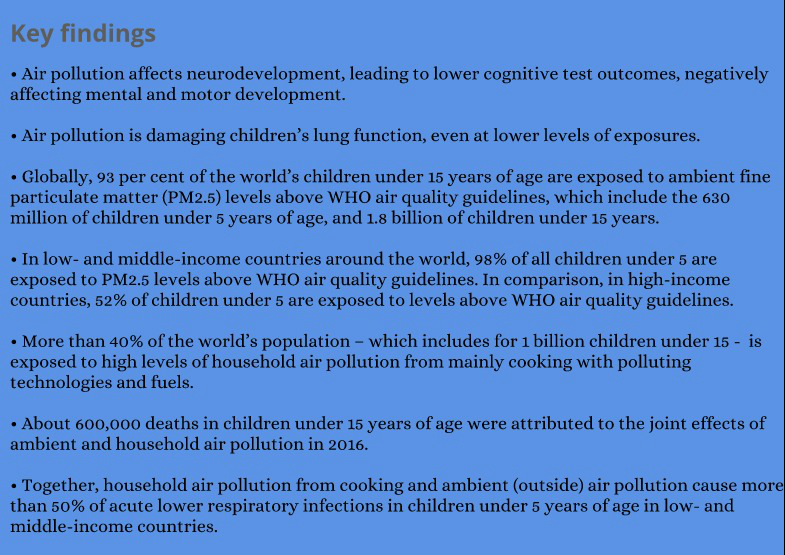Nine-year-old Londoner Ella Kissi-Debrah, who loved swimming, dancing and football, became the rare human face of a tragic statistic.
She had an asthmatic seizure and died when air pollution shot up near her home in February 2013.
It was the last in a series of asthma attacks in the years her family had lived there, 25 metres from London’s South Circular Road, a “notorious pollution hotspot”, and, like all but one of her hospital admissions, it coincided with a spike in air pollution in her locality.
The latter was one of the findings of a report by Prof Stephen Holgate, chair of the UK government’s advisory committee on the effects of air pollution, which, according to the BBC, said exposure to air pollutants was a “key driver” of Ella’s condition and concluded that “unlawful levels of air pollution contributed to the cause and seriousness of Ella’s asthma in a way that greatly compromised her quality of life and was causative of her fatal asthma attack”.
In 2016, around the world, the parents of 600,000 children just like Ella buried their kids.
That is the number of children who died that year from acute lower respiratory infections caused by polluted air, according to a new World Health Organization report released today, the eve of the first ever WHO Global Conference on Air Pollution and Health.
The report, Air pollution and child health: Prescribing clean air, found that every day around 93 per cent of the world’s children under the age of 15 years (1.8 billion children) breathe air that is so polluted it puts their health and development at serious risk.
It examines the heavy toll of both outdoor and household air pollution on the health of the world’s children, particularly in low- and middle-income countries.
“Polluted air is poisoning millions of children and ruining their lives,” says Dr Tedros Adhanom Ghebreyesus, WHO Director-General. “This is inexcusable. Every child should be able to breathe clean air so they can grow and fulfil their full potential.”
Air pollution also impacts neurodevelopment and cognitive ability and can trigger asthma and childhood cancer. Children who have been exposed to high levels of air pollution may be at greater risk for chronic diseases such as cardiovascular disease later in life.
One reason why children are particularly vulnerable to the effects of air pollution is that they breathe more rapidly than adults and so absorb more pollutants. They also live closer to the ground, where some pollutants reach peak concentrations – at a time when their brains and bodies are still developing.
Newborns and young children are also more susceptible to household air pollution in homes that regularly use polluting fuels and technologies for cooking, heating and lighting.
“Air pollution is stunting our children’s brains, affecting their health in more ways than we suspected. But there are many straight-forward ways to reduce emissions of dangerous pollutants,” said Dr Maria Neira, Director, Department of Public Health, Environmental and Social Determinants of Health at WHO.
The report also reinforces the evidence that when pregnant women are exposed to polluted air, they are more likely to give birth prematurely, and have small, low birth-weight children.

“WHO is supporting implementation of health-wise policy measures like accelerating the switch to clean cooking and heating fuels and technologies, promoting the use of cleaner transport, energy-efficient housing and urban planning. We are preparing the ground for low emission power generation, cleaner, safer industrial technologies and better municipal waste management, ” Dr Neira said.
This latest WHO report comes at the head of an overwhelming body of evidence that names air pollution as a major factor in a wide number of non-communicable diseases, including stroke, heart disease, cancer and diabetes, and links are emerging with other impacts like cognitive impairment, dementia and Alzheimer’s.
For young Ella’s family, knowledge of these links came too late, but Mum Rosamund campaigns for clean air in the hopes that awareness will protect the health of other children.
“If I’d known then what I know now, things could have been so different. I can’t turn the clock back, but I can now better protect my 11-year-old twins, who miss their big sister every day,” she said.
Read the full report here.
WHO’s First Global Conference on Air Pollution and Health, which opens in Geneva on Tuesday 30 October, will provide the opportunity for world leaders; ministers of health, energy, and environment; mayors; heads of intergovernmental organizations; scientists and others to commit to act against this serious health threat, which shortens the lives of around 7 million people each year. Actions should include:
• Action by the health sector to inform, educate, provide resources to health professionals, and engage in inter-sectoral policy making.
• Implementation of policies to reduce air pollution: All countries should work towards meeting WHO global air quality guidelines to enhance the health and safety of children. To achieve this, governments should adopt such measures as reducing the over-dependence on fossil fuels in the global energy mix, investing in improvements in energy efficiency and facilitating the uptake of renewable energy sources. Better waste management can reduce the amount of waste that is burned within communities and thereby reducing ‘community air pollution’. The exclusive use of clean technologies and fuels for household cooking, heating and lighting activities can drastically improve the air quality within homes and in the surrounding community.
• Steps to minimize children’s exposure to polluted air: Schools and playgrounds should be located away from major sources of air pollution like busy roads, factories and power plants.
Banner photo by Aulia Erlangga/CIFOR/CC BY-NC-ND 2.0.